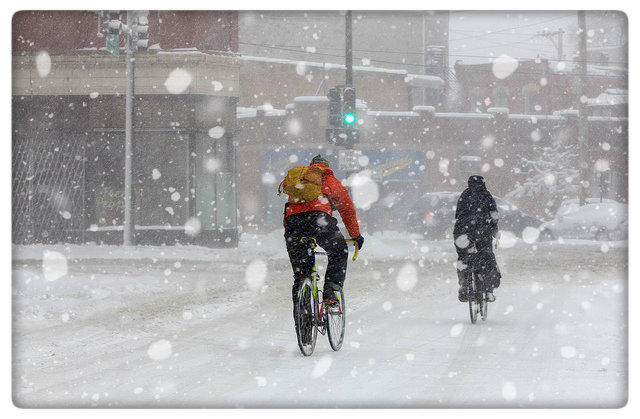December 22st is the first day of winter and although we have enjoyed a long stretch of mild weather, the cold and snow will be here soon. We have some winter driving tips and some winter biking tips to help keep you safe this winter.
Biking
- Layer up but do not overdress – look for clothing that is designed to keep you warm without being too bulky and make you sweat. Many stores sell active wear clothes that are both fashionable and functional. Cover your head, your extremities and your ears, and wear clear glasses to protect your eyes.
- Wear something bright and equip your bike with good lights (flashing lights have a great battery life but the high powered ones can blind the motorists behind you), it will keep you safe during low visibility conditions.
- Equip your bike with wide tires (studded winter tires are best for icy conditions) and shoes with threaded sole so you won’t slip when you break or stop at a light and you have to put your foot down.
- If possible, pick streets that will minimize your contact with cars.
- Think safety first! – Use your judgment in snowy, slippery and/or low visibility conditions, actively manage risk through strategies to avoid travel, minimize contact with other traffic and/or make yourself as visible as possible through proper lane positioning.
Driving
If possible, try to avoid driving in bad weather conditions. Don’t go out until the snow plows and sanding trucks have had a chance to do their work, and allow yourself extra time to reach your destination. If you must drive in snowy conditions, make sure your car is prepared, and that you know how to handle road conditions.
Driving safely on icy roads
- Decrease your speed and leave yourself plenty of room to stop. You should allow at least three times more space than usual between you and the car in front of you.
- Brake gently to avoid skidding. If your wheels start to lock up, ease off the brake.
- Turn on your lights to increase your visibility to other motorists.
- Keep your lights and windshield clean.
- Use low gears to keep traction, especially on hills.
- Don’t use cruise control or overdrive on icy roads.
- Be especially careful on bridges, overpasses and infrequently traveled roads, which will freeze first. Even at temperatures above freezing, if the conditions are wet, you might encounter ice in shady areas or on exposed roadways like bridges.
- Don’t pass snow plows and sanding trucks. The drivers have limited visibility, and you’re likely to find the road in front of them worse than the road behind.
- Don’t assume your vehicle can handle all conditions. Even four-wheel and front-wheel drive vehicles can encounter trouble on winter roads.
If your rear wheels skid…
- Take your foot off the accelerator.
- Steer in the direction you want the front wheels to go. If your rear wheels are sliding left, steer left. If they’re sliding right, steer right.
- If your rear wheels start sliding the other way as you recover, ease the steering wheel toward that side. You might have to steer left and right a few times to get your vehicle completely under control.
- If you have standard brakes, pump them gently.
- If you have anti-lock brakes (ABS), do not pump the brakes. Apply steady pressure to the brakes. You will feel the brakes pulse — this is normal.
If your front wheels skid…
- Take your foot off the gas and shift to neutral, but don’t try to steer immediately.
- As the wheels skid sideways, they will slow the vehicle and traction will return. As it does, steer in the direction you want to go. Then put the transmission in “drive” or release the clutch, and accelerate gently.
If you get stuck…
- Do not spin your wheels. This will only dig you in deeper.
- Turn your wheels from side to side a few times to push snow out of the way.
- Use a light touch on the gas, to ease your car out.
- Use a shovel to clear snow away from the wheels and the underside of the car.
- Pour sand, kitty litter, gravel or salt in the path of the wheels, to help get traction.
- Try rocking the vehicle. (Check your owner’s manual first — it can damage the transmission on some vehicles.) Shift from forward to reverse, and back again. Each time you’re in gear, give a light touch on the gas until the vehicle gets going.
Sources: National Safety Council, New York State Department of Motor Vehicles, Washington State Government Information & Services


